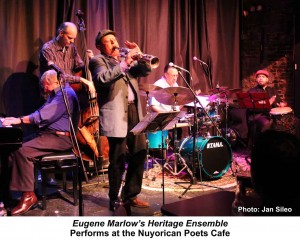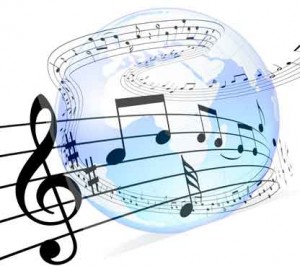In his 2005 book The World Is Flat: A Brief History of the Twenty-First Century (Farrar, Straus and Giroux), three-time Pulitzer- prize winning author and New York Times columnist Thomas L. Friedman points out in his penultimate chapter that the Dell notebook computer on which Friedman drafted his book was not put together in one place (a very old world manufacturing concept). In fact, it involved about four hundred companies in North America, Europe, and primarily Asia. In a very real sense, the computer was manufactured in the context of a global village (to borrow a phrase from the late Canadian-born media guru Marshall McLuhan)—a very new world concept.
The world of music in the 21st Century is similarly affected. In fact, the world of music is rapidly evolving into “world music.”
World Music
To quote from Wikipedia:
World music is a musical category encompassing many different styles of music from around the world, including traditional music, quasi-traditional music, and music where more than one cultural tradition intermingle.
World music’s inclusive nature and elasticity as a musical category pose obstacles to a universal definition, but its ethic of interest in the culturally exotic is encapsulated in Roots magazine’s description of the genre as “local music from out there.” . . . . Globalization has facilitated the expansion of world music’s audiences and scope. It has grown to include hybrid sub-genres such as world fusion, global fusion, ethnic fusion and worldbeat.
To further quote from Wikipedia:
The term [world music] has been credited to ethnomusicologist Robert E. Brown, who coined it in the early 1960s at Wesleyan University in Connecticut, where he developed undergraduate through doctoral programs in the discipline. . . .The term became current in the 1980s as a marketing/classificatory device in the media and the music industry, and it is often used to classify any kind of non-Western music.
World music, in effect, is also a reflection of the “flat world” we now live in. It can mean: (1) Traditional music from the developing world; and it can mean (2) Western popular music incorporating elements of such music. Both definitions are abundant in examples.
 An Evolution A Few Centuries in the Making
An Evolution A Few Centuries in the Making
World music as a genre did not come into being overnight, and certainly not since Professor Brown coined the term. It could be argued that world music began to evolve in the Renaissance shortly after Gutenberg introduced the movable type printing press in the mid-15th century followed by the development of printed music in Venice courtesy of Ottaviano Petrucci. Identified as the father of modern music printing, Petrucci, a printer and publisher, flourished in large measure thanks to a twenty-year monopoly of printed music in Venice during the early 16th century.
The meaning of both the Gutenberg printing press and Petrucci’s activities is that “composition” could now be shared by others on a broad scale.
Other Technological Progenitors
The other progenitors of world music over time, technologically speaking, are various developments in transportation, information, and communication. Briefly, the evolution of the steamship, cars, and planes in the late 19th and 20th centuries accelerated the distribution and therefore sharing of music on a global basis. It is a fact that the global airline industry has grown about 5% a year in the last 30 years (the effects of 9/11 notwithstanding). Developments in computer, satellite, radio, television, cable, CD, DVD, Internet and mobile electronic technologies have further accelerated this process.
It is no wonder, then, that those in the musical arts on a global basis are bumping into each other and are being influenced by each other’s musical traditions and cultures.
A Collision of Cultures: There’s No Longer Any “Pure” Music
It can be argued, therefore, that to define any kind of music as “pure” and untainted by outside musical and cultural influences is to look at the world through highly conservative eyes and to hear the sounds of the world through blocked ears.
 My own quintet, The Heritage Ensemble, is one example. In the early 1980s I was asked to play a traditional Hebraic melody at a weekend retreat. At the time I was studying jazz composition with pianist/composer/ educator Harold Danko. While working on the melody I discovered the jazz chord possibilities underneath the melodic line. As I explored this approach, I began to incorporate into other arrangements musical styles that appealed to my musical sensibilities −Afro-Caribbean, Brazilian, and even neo-classical.
My own quintet, The Heritage Ensemble, is one example. In the early 1980s I was asked to play a traditional Hebraic melody at a weekend retreat. At the time I was studying jazz composition with pianist/composer/ educator Harold Danko. While working on the melody I discovered the jazz chord possibilities underneath the melodic line. As I explored this approach, I began to incorporate into other arrangements musical styles that appealed to my musical sensibilities −Afro-Caribbean, Brazilian, and even neo-classical.
From this beginning has evolved first a trio, now a quintet, three CDs of arrangements and original compositions, and a growing number of live performances.
The evolution of the quintet is also largely due to the varied musical and cultural backgrounds of the personnel who have fallen in with me. The longest standing member of the troupe is bassist Frank Wagner. A Phi Beta Kappa with an academic background in jazz and education, his cultural background is Eastern European. Our saxophonist, Michael Hashim, broadly educated in jazz, has a Lebanese family heritage. He brings a Middle Eastern sensibility to our performances. The Ensemble also incorporates several percussionists, including Cristian Rivera, Obalinu Allende, and more recently Nelson Matthew Gonzales. All three are Nuyorican-born virtuoso percussionists. They have a musical and cultural heritage rich in Afro-Caribbean and West-African traditions. Our drummer is five-time Grammy nominee Bobby Sanabria. He is a walking encyclopedia on the history of Latin-jazz and a virtuoso drummer in his own right. My own family and cultural background is from Russia, Germany, Poland, and England. I have studied jazz and classical music.
Taken together, our collective musical and cultural backgrounds reflect the world music culture in which we now found ourselves. In a way, it is unavoidable. It is a collision of cultures we have all embraced. It informs our arrangements and propels our performances, particularly when it comes to the world music rhythmic patterns we employ.
Next week I’ll describe some of these rhythmic patterns (courtesy of Bobby Sanabria) and how they have influenced our performances.
Please write to me at meiienterprises@aol.com if you have any comments on this or any other of my blogs.
Eugene Marlow, Ph.D.
September 17, 2012
© Eugene Marlow 2012


